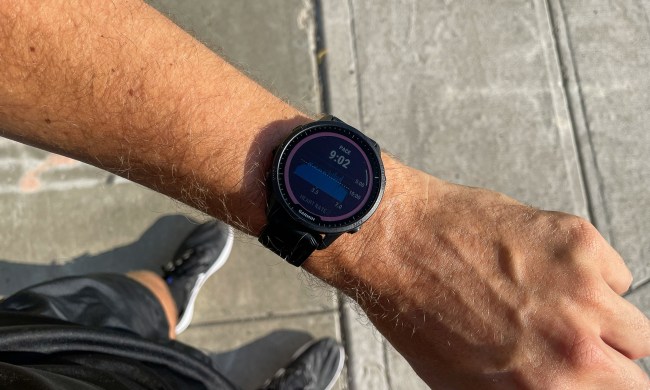
But hidden among the more well-known entries in the field are some pretty darn strange wearable devices, offering oddball functions like canine emotion tracking and actually playable air guitars. Here are 9 of our favorite devices from the weird side of the wearables business. And we don’t necessarily mean that in a bad way, either!
The rig that started it all

Let’s kick things off by paying tribute to Steve Mann, an engineering professor at the University of Toronto, who is credited as the father of wearable technology. Back in the early 1980s, Mann cemented his status as the world’s first cyborg by creating this bulky rig consisting of a backpack-based general-purpose multimedia wearable computer system, complete with a head mounted display.
It allowed him to move around while continuing to carry out personal computing applications. At the time, it seemed totally nuts. Today… well, he’s kind of been proved correct in his ambitions.
Headband temple massager
Want to relieve that headache that’s building in your cranium, but too tired to move your arms? No problem: the Vi-Band hands-free head massager promises to do it for you. It’s a neoprene band with built-in brushless vibration motors designed to sit over the head’s pressure points and give you a calming massage.
Combine it with a curved neck pillow and you’ve got the perfect solution to any long haul flight. Even if headbands do make you look a bit like you’re cosplaying as a 1980s sports star.
A wearable for, you know, down there

Ever dreamed of quantifying your love life? Quite possibly not. If you have, however, then you may be in the market for Lovely, the wearable for your penis. The slip-on device communicates with your
It will monitor all your, erm, intimate movements and then send the numbers to make some kind of weird bar graph with. Heck, it’ll even tell you how many calories you’ve burned and use Amazon-style recommendations to suggest other maneuvers you may be interested in. What a glorious time to be alive!
A wearable keyboard
It’s kind of impolite to constantly be tapping away at your
That’s pretty much what the Tap Strap promises to deliver. To be fair, it’s actually a pretty cool sounding device — although the thought of entire subway trains of people nervously tapping out Morse Code-style messages on the commute to work does make us laugh.
Pho-dog-raphy
Emotion tracking is pretty darn exciting, and opens up some intriguing possibilities. One of the weirder ones? An emotion sniffing camera for dogs, which measures Fido’s heart rate and takes a photo every time it passes a threshold. If you ever wanted a commemorative set of images of whichever fire hydrants, cats, and sprinklers most excited your mutt on their walk, this is a great idea — albeit an unusual one.
Unfortunately, the Heartography device was created as a one-off hack for a Nikon Coolpix ad, and isn’t available to purchase. Still, there’s nothing to stop the more talented, canine-loving engineer from building his or her own.
A mask that changes with your emotions
Feeling left out of the emotion tracking fun? Thanks to this emotion tracking mask you don’t have to be. Created by a team of designers from London’s Bartlett School of Architecture, using 3D printing and Harvard University’s Soft Robotics Toolkit, this soft silicone mask changes its pattern depending on the expression made by its wearer.
It does this using a MyoWare Muscle Sensor, an Arduino-powered, all-in-one electromyography (EMG) sensor, which measures the activity of facial muscles and then outputs a signal which triggers a response. Pointless? Perhaps. Kind of awesome in a Rorschach from Watchmen way? You betcha!
A wearable to stop you cheating
That dishy hunk in the office who you’ve always flirted with, and is now newly single? That tempting Tinder account that reminds you that there are girls just like your girlfriend, but who wouldn’t laugh at you for attending Comic Con? That kind of cheating is so five years ago.
Here in 2018, the real threat to many relationships is the chance that either you or your partner will jeopardize your relationship by forging ahead with a TV series on Netflix when you’re not there. The Commitment Ring wearables aims to end this kind of trust-destroying villainy. The rings come in packs of two, both outfitted with
A genius idea — although they’re currently still listed as being pre-order only.
The world’s greatest air guitar
Developed as part of Sony’s Motion Sonic Project, the Motion Sonic wearable turns users’ movement into music. The idea of being able to play air guitar and have it actually sound like a guitar is all kinds of awesome, but Motion Sonic also covers a broad range of other instruments.
While it’s certainly pretty chunky, that extra space is used to pack in a “six-axis sensor” that’s able to track the rotation, angle, and acceleration of a wearer’s leg or arm, in addition to a trio of microphones. Prototypes of the device have been shown off at events like the South By South West (SXSW) festival.
A wearable for plants
Who said you needed to be human (or, well, canine) to have a wearable designed for you? Researchers at Iowa State University has developed wearable sensors for plants, which allow their growers to measure how their crops are using water.
Described as “plant tattoo sensors,”the devices use graphene to track how leaves release water vapor by measuring changes in conductivity. They’re not available to farmers just yet, but it’s an amazing glimpse at the future promise of wearable devices. Things will only get weirder from here.



